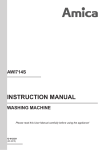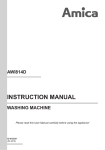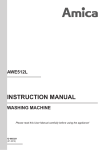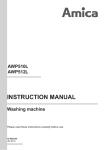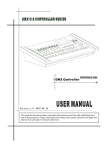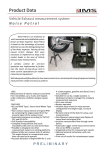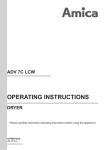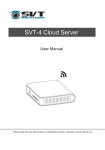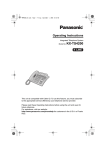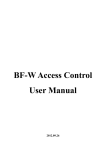Download Washing Machine - Chestnut Lodge
Transcript
AWB510LP INSTRUCTION MANUAL WASHING MACHINE Please read this User Manual carefully before using the appliance! IO 00590/1 (10.2013) CONTENTS Basic Information.......................................................................................................................3 Notes on Safety..............................................................................................................4 Installing the Washing Machine...................................................................................................6 Understanding the symbols on clothes labels................................................................8 Description of control panel..........................................................................................9 Using the appliance................................................................................................11 Table of programmes.........................................................................................12 Troubleshooting..................................................................................................................14 Maintenance and Cleaning.......................................................................................15 Practical tips on washing.....................................................................................................16 Specification......................................................................................................19 Service and Warranty..................................................................................................19 Product Fiche........................................................................................................20 In accordance with European Directive 2002/96/EC and Polish legislation regarding used electrical and electronic goods, this appliance is marked with the symbol of the crossed-out waste container. This marking means that the appliance must not be disposed of together with other household waste after it has been used. The user is obliged to hand it over to a waste collection centre collecting used electrical and electronic goods. The collectors, including local collection points, shops and local authority departments provide recycling schemes. Proper handling of used electrical and electronic goods helps to avoid environmental and health hazards resulting from the presence of dangerous components and the inappropriate storage and processing of such goods. 2 BASIC INFORMATION Dear customer, From today, washing will be easier than ever before. The Amica washing machine combines exceptional ease of use with excellent effectiveness. Once you have read the instructions, operating the washing machine will not be a problem. Before being packed and leaving the factory, the safety and functions of this washing machine were carefully tested. After these tests some moisture or water may remain in the appliance. We ask you to read the User Manual carefully before switching on the appliance. Following the directions in this manual will ensure proper operation and safe use of the appliance. Keep this User Manual and store it near at hand. The instructions should be followed carefully to avoid any unfortunate accidents. Important! This washing machine is intended for domestic use only to wash textiles and clothes designed to be machine washed in a detergent bath. Before plugging the washing machine into the mains, remove the safety packaging and ensure the machine is level. The manufacturer reserves the right to make changes in the appliance, which do not affect its operation. Use lCarefully read the instructions below before using the appliance lNever use the machine outdoors or anywhere the temperature may fall below freezing. lThe machine should not be operated by children or anyone who has not read the instructions. Important! Temperatures below 0°C can damage the washing machine! In the event of the machine being stored or transported in sub-zero temperatures, it should be left to acclimatise in a temperature above zero for 8 hours before being used. Manufacturer’s Declaration The manufacturer hereby declares that this product meets the requirements of the following European directives: l Low Voltage Directive 2006/95/EC, l Electromagnetic Compatibility (EMC) Directive 2004/108/EC, l ErP Directive 2009/125/EC, and has been marked with the symbol and issued with a declaration of compliance made available to market regulators. 3 NOTES ON SAFETY l Detergents Use only those detergents and additives which are designed for automatic washing machines, especially when using the COTTON 90°C programme. Do not use any agents containing solvents, as these may damage certain parts of the machine, or cause them to emit poisonous gases. There may also be a risk of ignition and explosion. l Loading the Ensure no unwanted objects are put inside the appliance. Completely empty all pockets in the clothing to be washed and fasten buttons and zips. Place small, loose objects in a washing bag, or inside a pillow case, as they may be destroyed or else damage the drum or internal tank. Do not exceed the recommended maximum load of washing. Machine l Control Panel Protect the control panel from water spillage. Do not put washed clothes on top of the machine! l Transport Unplug the machine before preparing the machine for transport. Do not transport the washing machine if drum locking bolts are not in place. See the chapter INSTALLING THE MACHINE (page 6). Keep the appliance in upright position when transported. l Data Plate Data plate indicating basic information about the washing machine is located at the top part of the rear casing. l Burns The door glass of your washing machine is hot during operation. Do not allow children in the vicinity of the appliance. 4 NOTES ON SAFETY Checking stability Once the washing machine is in position and levelled, it must be checked to ensure it is standing in a stable position on all four legs. In order to check this, press down each corner of the appliance in turn to see if it moves. The safe, long-term and reliable operation of the washing machine depends on it being correctly positioned and level. Important! Level the appliance, remove the drum locking bolts and wait 3 hours before using the appliance for the first time. Important! Incorrect levelling, especially instability, may cause the washing machine to move around during operation. This appliance is not intended for use by persons (including children) with physical, mental or sensory handicaps, or by persons inexperienced or unfamiliar with the appliance, unless under supervision or in accordance with the instructions as communicated to them by persons responsible for their safety. Ensure that children do not play with the appliance. Withdrawal from Use To ensure safety, the washing machine must be disabled once its useful life comes to an end. First unplug it and then cut off the power lead. Scrap the appliance in line with local waste disposal legislation. 5 INSTALLING THE MACHINE I. Remove the protection used for transporting the appliance (keep the locking bolts for future use, e.g. when moving house). lUnscrew the 4 locking bolts with a spanner. lRemove the rubber and plastic transport lStop up the holes with the stoppers enclosed in the accessories bag. brackets from the sockets along with the washers and bolts. The locking bolts MUST be removed before the washing machine is used! II. Positioning and levelling the machine lDo not place the washing machine on a carpet! lThe floor surface should not be either concave or sloping! lAttention should be paid to the shape of the surface of the floor, so that the entire weight of the appliance rests on its legs (not its body)! l Place the washing machine on a solid, even surface. l Loosen the plastic washer (2) l Level the machine by adjusting the legs (1) l Lock with washers (2) After positioning and levelling the machine, check that it is stable by pressing down each corner and ensuring it does not move! 6 INSTALLING THE MACHINE III. Connecting the water supply Use the new hoses supplied with the machine. Do not re-use old hoses. A water supply hose with seals is inside the drum of the machine. Water pressure min. 0,03 MPa (0,3 bar), max.1 MPa (10 bar). Supply the machine with cold water lafter connecting, make sure the hose is not twisted lafter connecting the hose and the valve, check they are sealed tight lregularly check the condition of the supply hose. IV. Water drain max 100 cm min 60 cm The drain hose is at the back of the machine. Fix the drain hose so that it does not move while the machine is in operation (use the elbow as shown below). Do not place the hose too deep into the outlet pipe! V. Connecting the electric power supply l The appliance’s mains connection (electrical wall socket) should be in a visible and accessible place! l Only plug the machine into a properly installed socket with an earth pin! l Do not connect to an adaptor or an extension cord! l In the event of the power lead being damaged, it must be l replaced by an authorised technician. The electrical system to which the appliance is to be connected must be protected with a 10 A fuse. 7 UNDERSTANDING THE SYMBOLS ON CLOTHES LABELS 90 I. Washing boiling temp. 900 normal temp 600 C delicate normal temp 400 C DO NOT wash! handwash II. Chemical cleaning all solvents all except TRI petrol only DO NOT dry clean! normal low high DO NOT dry! 1500C 2000C DO NOT iron! III. Spin dryer IV. Ironing 1100C Always pay attention to the symbols on garments’ labels when choosing a washing setting. DESCRIPTION OF THE APPLIANCE Control panel Detergent Drawer Door handle Drum Pump filter cover 8 DESCRIPTION OF CONTROL PANEL 1 2 4 5 6 3 7 8 9 1. Programme selector knob 2. End Indicator 3. Ready Indicator 4. Pre-wash Indicator 5. No spin Indicator 6. Start/Pauza Indicator 7. Pre-wash button 8. No spin button 9. Start/Pauza button 1. Programme selector knob Choose the appropriate wash programme as required, depending on how dirty the clothes are, and type and amount of laundry loaded, which ensures better results and more effective washing. Once the wash programme is started, turning the programme selector knob to another position (except ) does not change the previously selected programme. 2. End Indicator Lights after the wash programme has ended. 3. Ready Indicator Lights before the wash programme begins. 4. Pre-wash Indicator Lights when the function is active. 5. No spin Indicator Lights when the function is active. 6. Start/Pause indicator Lights after wash programme starts. If you Pause the programme, indicator will flash. 9 DESCRIPTION OF CONTROL PANEL 7. Pre-wash button Activation of function is indicated by an indicator lighting up next to the function name. Note: The Pre-wash function is not available for all programmes (see Table of wash programmes). The Pre-wash function extends the wash cycle by approximately 15-20 minutes. The laundry is prewashed before the main wash cycle begins (cold wash for the programs: Cottons 90°C, Cottons 60°C intensive wash, Cottons 60°C, Cottons 40°C; wash at 30°C for the programs: Synthetics 60°C and Synthetics 40°C). Activation of the Pre-wash function will allow you to achieve excellent washing results without the need to soak the laundry. Pre-wash is especially recommended when washing heavily soiled laundry. Note: Pour suitable detergent to detergent drawer marked with symbol before the Prewash function is activated. 8. No spin button Activation of function is indicated by an indicator lighting up next to the function name. The no spin function is especially useful for washing delicate garments. When this function is enabled, washing machine’s drum will not spin and instead it will rotate at low speed for a short time. 9. Start/Pause button Press [Start/Pause] to start or pause a programme. When the washing machine operates, START/PAUSE indicator light is on. When you PAUSE a programme, START/PAUSE indicator flashes. The Pause mode can be used to soak the laundry. Once the selected programme has started wait for about 10 minutes and then press the Start/Pause button. When the laundry is soaked as required, press the Start/Pause button again to resume the programme. Soaking will improve washing results for heavily soiled laundry. 7 + 9 Child Lock This function locks the function buttons to prevent settings being changed or the operation being interrupted by children. To set Child Lock, simultaneously press and hold 7 (Prewash) and 9 (Start/Pause) buttons for approximately 3 seconds. To release the Child Lock, hold the same buttons down once more for around 3 seconds. Child Lock will be automatically released after the wash cycle is completed. Note: When the child lock is activated Pre-wash and no spin indicators will flash a few times. When the child lock is release Start/Pause indicator will flash a few times. 10 USING THE APPLIANCE I. Programme selection 1. Set the programme selector knob to the desired programme (see the table further on), Ready indicator will light. 2. Activate available additional functions to modify the programme to your individual needs. 3. Press the [Start/ Pause] button. II. End of the wash cycle 1. End lights to indicate wash cycle has ended. 2. Turn off the water valve. 3. Set the programme selection knob to . 4. Unplug the appliance from the mains. 5. Open the door and remove the laundry. III. Cancelling and changing programme Set the programme selector knob to position for several seconds to terminate a programme. Then select the desired wash programme. 11 TABLE OF PROGRAMMES Programme name Cotton 90 Intensive wash 60 Max. temp. °C Max. spin speed [rpm] 90° 1000 60° Max. load [kg] Additional functions available Pre-wash No spin 5 Option Option 1000 5 Option Option Cotton * 60° 1000 5 Option Option Cotton * 40° 1000 5 Option Option Eco 40 40° 1000 5 - Option Quick wash 30 30° 800 2,5 - Option Eco 20 20° 1000 2,5 - Option Synthetics 60 60° 800 2,5 Option Option Synthetics 40 40° 800 2,5 Option Option (cold water) 800 2,5 - Option Delicates 30 30° 600 1,5 - Option Wool 30 30° 600 1,5 - Option Rinse - 1000 5 - Option Spinning - 1000 5 - - Drain - - - - - Synthetics cold * - standard programmes for washing cotton fabrics at 60°C and 40°C. These programmes are suitable for washing normally soiled cotton fabrics. They are simultaneously the most effective programmes for washing these type of fabrics, taking into account the total energy and water consumption. Note: Real water temperature may differ from the declared wash cycle temperature. Use detergent or fabric softener if necessary, l Detergent required, without which washing will be ineffective x Do not use detergent or fabric softener 12 TABLE OF PROGRAMMES Detergent drawer Time [h:min] Energy consumption (kWh) Water consumption (l) Number of rinses Type of laundry Prewash Basic wash x l 2:35 1,96 75 3 l 2:20 0,89 74 3 x l 3:10 0,85 45 2 x l 3:00 0,82 45 2 x l 1:20 0,39 43 2 Heavily soiled cotton or linen clothes. x l 0:30 0,16 40 2 Lightly soiled, sweaty cotton clothes and linen. x l 1:50 0,17 56 3 x l 1:24 0,95 45 2 Moderately soiled delicate synthetics, or synthetic and cotton compositions. x l 1:05 0,53 45 2 Lightly soiled delicate synthetics, or synthetic and cotton compositions. x l 1:12 0,12 45 2 Lightly soiled delicate synthetics, or synthetic and cotton compositions (water is not heated). x l 1:10 0,34 56 3 Very delicate fabrics. x l 1:13 0,29 52 3 Note: Do not machine wash woollen fabrics if the cloth tag prohibits. x x 0:28 0,04 41 3 Rinsing with improving agents, including. antistatic or softening additives. Reduce the spin speed when washing very delicate fabrics. x x x 0:10 0,02 * * Spin-drying after hand washing. x x x 0:02 0,01 * * Drain water - no spinning. Fabric softener Heavily soiled clothing, or an moderately soiled cotton and linen for children that requires boiling. Moderately or heavily soiled cotton clothes, bed linen, table linen, linen, towels. Moderately soiled cotton or linen clothes. Lightly soiled, sweaty cotton and linen clothes. Wash at 20°C NOTE: Above-mentioned the time is an estimate and may differ from actual wash cycle time, depending on temperature, water pressure, load size, etc. The time is automatically updated during wash cycle. Displaying the same time for an extended period or abrupt changes are normal. 13 TROUBLESHOOTING The fault indicator lights The washing machine indicates error codes to help locate minor operating faults and identify their cause. An error is indicated by LEDs on the control panel [Ready/ Start/Pause]. The appliance interrupts operation upon encountering an error. Error Code - The status of individual LED indicators l ☼ Reason Solution Ready Start/Pauza l ☼ Door is not closed properly Check that the door is locked; check that laundry is not jammed in the door ☼ l Low pressure, no water in the drum Unscrew the water valve, check the water inlet hose and filter, check the water pressure ☼ ☼ Water does not drain properly Check water drain pump and filter Others Try to restart or contact the Service Centre: tel. 0844815 8880 / 0818 45 46 46 Off Flash 14 MAINTENANCE AND CLEANING Never clean the product’s casing or plastic parts using solvents or strong, abrasive cleaning agents (e.g. washing powders or creams)! Only use delicate liquid cleaning agents and soft cloths. Do not use sponges. I. Cleaning the pump filter lUnplug the appliance from the mains, lTurn off the water valve, lOpen the filter cover by hand or using a flat-head screwdriver. Clean the pump filter every 20 washes or so. Neglecting to clean the filter causes difficulties in emptying the machine of water! lUnscrew the filter. Pump filter lRemove and clean the filter. To replace the filter following the procedure in reverse order. II. Cleaning the water supply valve lTurn on the water supply hose, lUse forceps to grasp the filter mesh plunger, lRemove and clean the filter (using a brush). To replace the filter following the procedure in reverse order. III. Cleaning the detergent drawer (at least once a month). l Remove the drawer (while pressing the stop). l Clean in running water (or using a lReplace the drawer. brush or piece of cloth). 15 PRACTICAL ADVICE REGARDING WASHING I. Cleaning and purifying agents It is recommended to use powder or liquid general purpose detergents for all temperatures in a range as per the detergent Producer’s recommendations indicated on the product packaging. Detergents lPour the detergent into the drawer compartment marked l Pour the pre-wash detergent into the drawer compartment marked Liquid detergents lInstall the supplied partition in the compartment (figure below). lPour liquid detergent into the drawer compartment marked Fabric softeners added to the rinse lPour the fabric softener into the drawer compartment marked lDo not exceed the maximum level marked on the drawer compartment. This detergent will be used for the final rinse. II. First wash Before washing for the first time, put it through one high temperature cycle without a load, according to the following procedure: lConnect the washing machine to the electricity mains lTurn on the water valve lSet the programme selector knob to high temperature wash. l Add the appropriate detergent and press the [Start/ Pause] button. III. Soil Stubborn stains Before washing garments, apply an additional stain remover according to the instructions for use Heavily soiled: lOne-off washing of smaller amounts of clothes lAdd more detergent lAfter washing heavily soiled clothes (e.g. working clothes) or garments which are shedding fibres, it is recommended that the washing machine is rinsed out by running a programme cycle at a temperature of 60°C, e.g. COTTON or SYNTHETICS, without a load. Lightly soiled: lSee pt. „Conservation”. IV. Conservation Reducing energy and water consumption Garments which are only lightly soiled should be washed using the appropriate wash programme, i.e. ULTRA SHORT The washing machine detects partial load. For partial load, when using the Towels and Cotton programmes, washing machine will reduce water and energy consumption and shorten the wash cycle. 16 PRACTICAL ADVICE REGARDING WASHING V. Water hardness Hard water causes sediment to form. Information about water hardness is available from your nearest water works. It is advised that water softeners are used for every wash. VI. Power cut (programme memory) Power cuts or unplugging the machine does not cancel the setting. This has been memorised and the cycle will continue once the power is restored. Do not open the doors of the washing machine during a power cut. VII. Loading Maximum drum capacity 5 kg: Load the washing into the drum according to the following instructions: lcotton, denim, children’s clothes – max full drum (do not force clothes into the drum as this will reduce the quality of the wash!). lsynthetics - max 1/2 drum lwool, silk, delicate fabrics - max. approx. 1/3 of the drum. Important! Do not overload the machine! Overloading the machine may cause damage to the clothes being washed! The maximum load amounts depending on the program are given in table of programs. VIII. Even load distribution control The electronic control device includes a load distribution control system. In the event that the system detects uneven distribution of load in the drum, the washing machine will try to relocate it. Sometimes the trials will not be sufficient for the proper location of the clothes (in the case of frotte dressing gowns washed with other types of clothes, ball-shaped sheets which closes several objects inside it). The system may react in the following way: lit may accept the uneven distribution of clothes but will decrease the spin speed lit may not allow spinning as the clothes are distributed unevenly.) In both cases, after the wash is over, open the door of the washing machine, place the laundry manually, close the door and select the spin programme again. 17 PRACTICAL ADVICE REGARDING WASHING IX. Door interlock The washing machine is equipped with an interlock which prevents the door from being opened during washing. Once a washing cycle is complete, the door interlock is automatically released. In order to open the door during the wash program, press PAUSE button and wait about 2 minutes to unlock the door. IMPORTANT! If the temperature inside the drum is high, the door may remain blocked until the water temperature has dropped below 60°C. IMPORTANT! Before opening the door of the washing machine check whether there is water in the drum. X. Delicate fabrics Programme: lSelect the appropriate wash programme (SYNTHETICS, WOOL, DELICATES) Loading: Do not overload the machine, max 1/3 of the drum, see Loading. XI. Dosing According to the cleaning agent manufacturer’s instructions. Too little cleaning agent lThe washing turns grey. lLumps of grease form, sediment builds up. Too much cleaning agent lStrong foaming. lIneffective washing, detergent incompletely rinsed from fabrics. 18 SPECIFICATION -Type -Rated voltage -Rated power -Current protection -Drum capacity -Water pressure AWB510LP 230V / ~50Hz. 2100 W 10 A max 5 kg min 0,03 MPa (0,3 bar) max 1 MPa (10 bar) -Dimensions/Height/Breadth/ Depth 845 / 597 / 497 [mm] -Weight 64,5 kg -Meets the requirements of EU legislation, EN 60456 standard. Testing for label information in accordance with EN 60456 using the standard cotton wash programmes: - Cotton 60°C at full load - Cotton 60°C at partial load - Cotton 40°C at partial load laverage annual water consumption is 9240 litres, lweighted average electricity consumption is 167 kWh/year 19 PRODUCT FICHE Pursuant to a Delegated Regulation of the Commission (EU) No. 1061/2010 of 28 September 2010 supplementing the Directive of the European Parliament and of the Council 2010/30/EU on the energy labelling of household washing machines and Regulation of the Commission (EU) No. 1015/2010 of 10 November 2010 on the implementation of the Directive of the European Parliament and of the Council No. 2009/125/EC on the Eco design requirements for the household washing machines). Amica Wronki S.A. Supplier’s name or trade mark AWB510LP Type Rated capacity 5,0 kg Energy efficiency class1)2) A+ Weighted annual energy consumptio AEc 167 kWh/year 3) Energy consumption of the standard cotton programme: - 60°C at full load Et,60 0,85 kWh - 60°C at partial load Et,601/2 0,66 kWh - 40°C at full load Et,401/2 0,52 kWh Power consumption of the off-mode Po 0,2 W Power consumption of the left-on mode PI 1W Weighted annual water consumption AWC4) 9240 l Water consumption of the standard cotton programme: - at 60°C, full load Wt,60 43 l - at 60°C, half load Wt,601/2 41 l - at 40°C, half load Wt,401/2 41 l Spin-drying efficiency class 2) C Residual humidity D 62 % Maximum spin speed attained 2) 1000 rev / min Duration of the standard 60°C cotton programme at full and partial load 190 min Duration of the standard 60°C cotton programme at partial load 145 min Duration of the standard 40°C cotton programme at partial load 140 min Noise Level: - during the wash cycle 58 dB(A) re 1 pW - during the spin cycle 77 dB(A) re 1 pW Equipment designed for fitting No Energy efficiency class on a scale from A+++ (more efficient) to D (less efficient). For a standard Cottons 60°C and 40°C intensive wash programme at full and partial load. Estimated weighted annual energy consumption based on 220 standard wash cycles for Cottons 60°C and 40°C intensive wash programmes at full and partial load and energy consumption in power saving modes. Actual energy consumption depends on how the appliance is used. 4) Estimated weighted annual water consumption based on 220 standard wash cycles for Cottons 60°C and 40°C intensive wash programmes at full and partial load. Actual water consumption depends on how the appliance is used. 1) 2) 3) 20 21 22 23

























